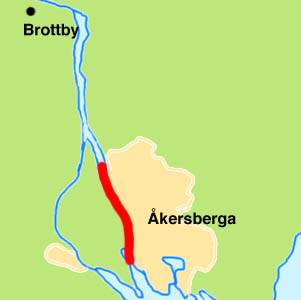View towards south from the lock.
Lock chamber
The canal upstreams the lock
Åkers canal at Norrö
View towards Garnsviken from Åkers kanal

View towards south from the lock. | Lock chamber | The canal upstreams the lock |
Åkers canal at Norrö | View towards Garnsviken from Åkers kanal |
© Pictures by Mike Bonnier, 2001
Total length | Total elevation | Number of locks | Max boatlength | Max boatwidth | Max draught | Max free height | Max Speed |
10,7 km | 1,8 m | 1 | ? m | ? m | 1,5 m | 2,2 m | 5 knots |
History:
This was an important trade route between Uppsala and the sea in the iron-age. Todays Åkers canal was the last link to the sea. At that time there was an alternative route from Stafabay via some small lakes to the sea.
During the Viking age the middle part of the route was so shallow that the Vikings had to pull their boats past.
Landelevation was one problem, another was that the farmers along the route had permanent fishing tackle that hindered the boats. The king Gustav Vasa threatened the farmers that they had to clear the fairway to let the fishermen through to the marketplace at Lunda with fish and salt.
By the middle of the 18th century the alternative route was totally unusable and the passage at Åker was so shallow that it was possible to walk dry across at low water. At Runö there were new streams.
By the end of the 18th century some of the biggest landowners in the area wrote a petition to the provincial council and demanded a thorough clearing up of the fairway. This was obviously a delicate question as they had to wait 21 years for the answer!
But the answer was the building of a canal at Åker and clearing up of other parts of the fairway as well as dredging parts of the approaches from the sea.
The canal was built between 1822 and 1824 for 94 040 SEK all of which the government paid. Some soldiers worked here as well as boatmen form the area.
In the mid 1850ies a steamer started passenger traffic between Brottby and Stockholm. From 1880 this route was run by the legendary steamer "Åkers Kanal". The tour was done at 4 hours. Local people named the steamer "The Cock" as everbody in the area was wakened early every morning by the steamwhistle. In the 1920ies the traffic decreased and the route closed in 1927.
In 1861 Åkers Kanal-bolag was formed and assumed the management of the canal. In 1969 the Östanåker municipality bought all the shares. The company was renamed AB Åkers Kanal and now manages all the public harbours in the municipality, as well as other maritime issues.
The canal was improved in 1886, 1907, 1910, 1914 and 1921.
In 1919 647 ships passed the canal and in 1991 296 boats passed the lock.
Museums: Båtsmansmuseet, Hembygdsparken Ekbacken, Kanalmuseet, Gamla slussvaktarbostaden, Åkersbro.
This page was modified at